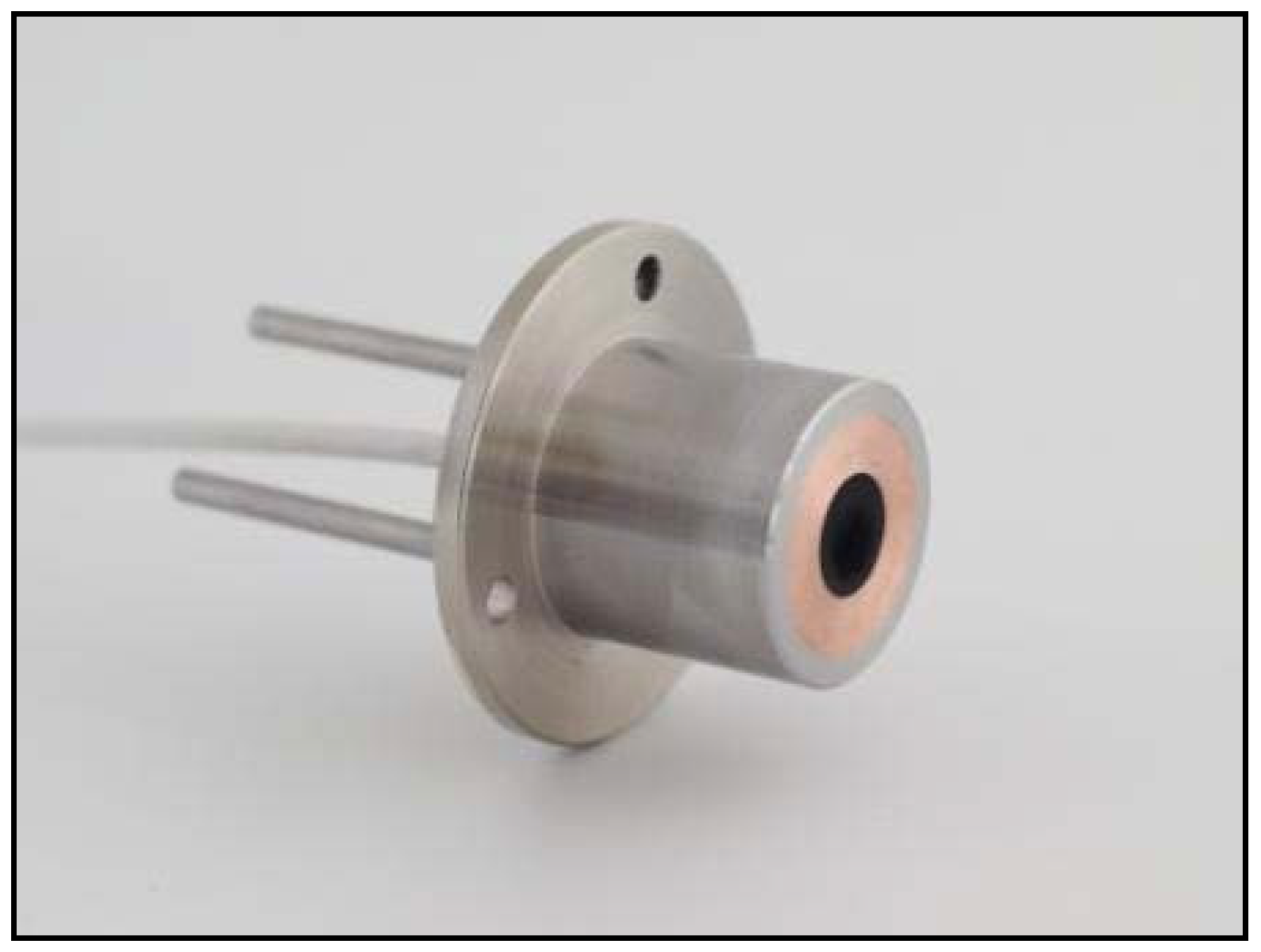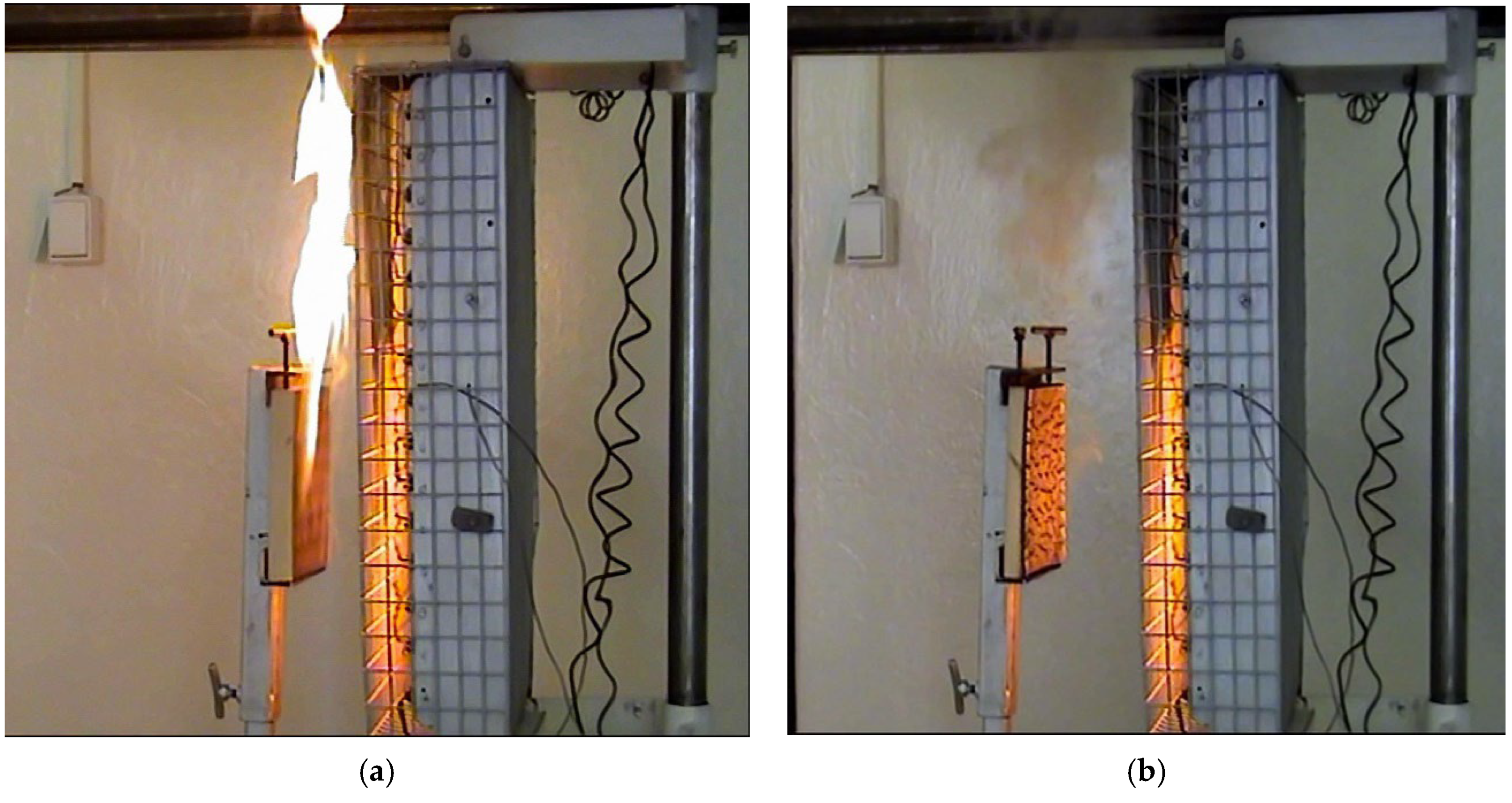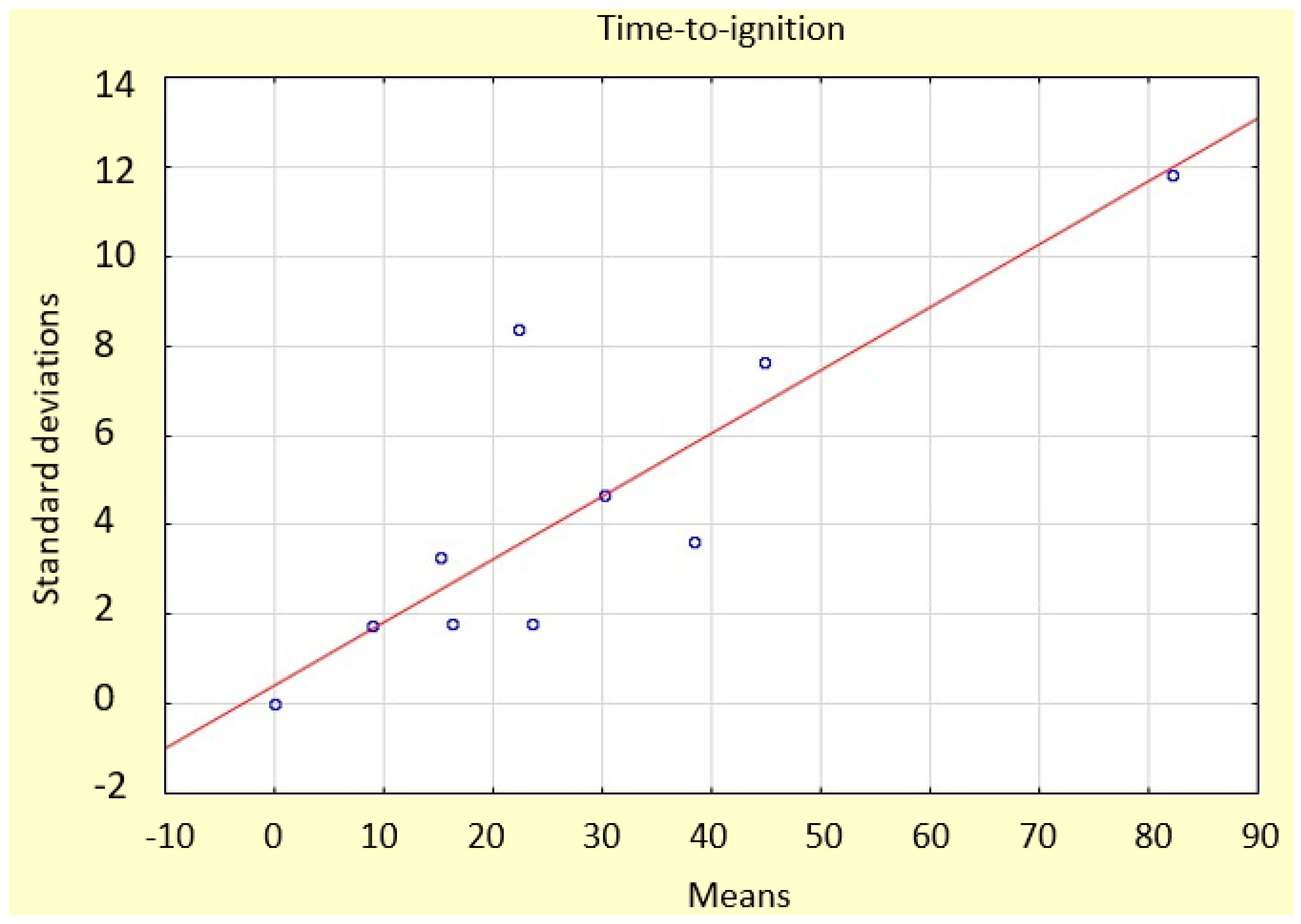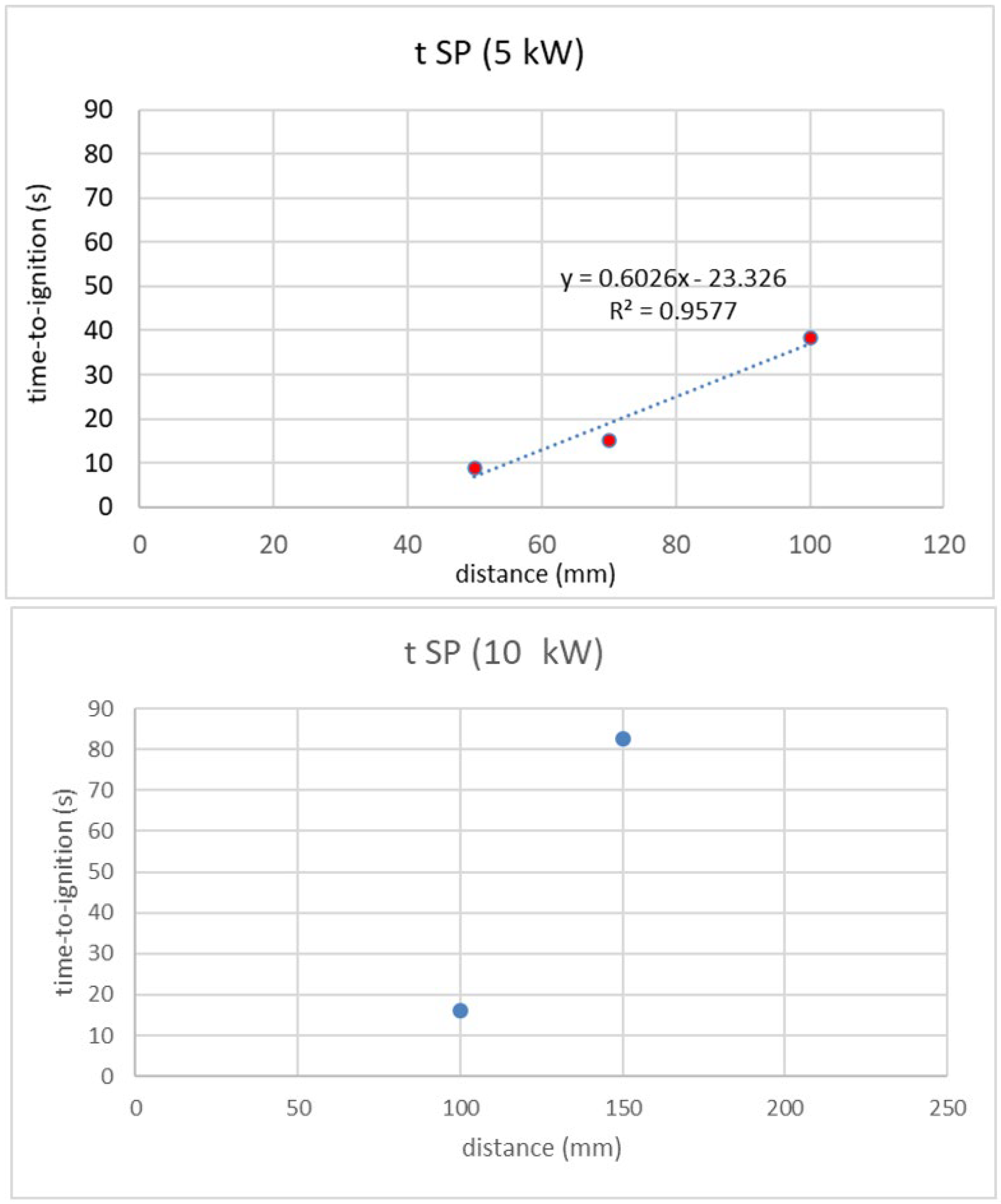Study of the Influence of Heat Flow on the Time to Ignition of Spruce and Beech Wood
Abstract
:1. Introduction
- To verify the dependence of the heat flow on the wood density and flammability of materials based on the prediction of the physical properties and fire characteristics of spruce (Picea abies L. Karst.) and beech (Fagus sylvatica L.) wood samples;
- To experimentally determine the time to ignition (TTI) of spruce and beech samples;
- To investigate the significant impact of heat flux (in the range of 13–92 kW.m−2) generated by an electric radiant panel (at two power levels of 5 kW and 10 kW) and the position of samples (at the distance of 50, 70, 100, 150, and 200 mm from the heat source) on the ignition temperature and time to ignition.
2. Materials and Methods
2.1. Materials
2.2. Methods
2.3. Method and Evaluating the Obtained Results
- To determine the time to ignition of samples of beech and spruce wood exposed to the selected value of radiant heat flux. The measurement of the time to ignition of the sample (HAMA Sports Stopwatch SW-104, HAMA GmbH & CoKG, Monheim, Germany) represented the interval from the time the sample was placed in the holder at the specific distance until permanent surface ignition of the sample occurred. If permanent surface ignition did not occur and the sample only burned without flames, the test was terminated after 15 min.
- To evaluate the results using the statistical method ANOVA according to the STATISTICA 10 programme.
3. Results and Discussion
4. Conclusions
- With a radiant panel power of 5W, flaming combustion occurred for samples of spruce and beech wood at all distances (50, 70, and 100 mm), for all heat flux values, except for the last sample of beech wood placed at a distance of 100 mm, corresponding to a heat flux value of 64 kW·m−2.
- In the experimental results, the ignition time for beech wood was approximately twice that of spruce wood, likely due to the higher average wood density (700.72 ± 21.9 kg·m−3 for beech wood compared to 421.7 ± 30.46 kg·m−3 for spruce wood).
- With a radiant panel power of 10 W, flaming combustion was observed for samples of spruce and beech wood only at two distances (100 and 150 mm). At a distance of 200 mm (with a corresponding heat flux of 47 kW·m−2), the samples did not undergo flaming combustion; however, the influence of heat flux was evidenced by non-flaming combustion.
- The statistical analysis, employing ANOVA followed by the Kruskal–Wallis test, examined variables including wood type, radiant panel output, distance, and heat flux in relation to ignition time. The analysis revealed a significant difference between ignition time and distance (p-value = 0.0000, H = 37.51583) as well as between ignition time and heat flux (p-value = 0.0000, H = 37.69726).
- Time-to-ignition values significantly depend on both the radiant panel output and the distance of the sample from the heat source.
- As the radiant panel power increased, the differences in the time to among the tested samples also increased.
Author Contributions
Funding
Institutional Review Board Statement
Informed Consent Statement
Data Availability Statement
Conflicts of Interest
References
- Jiang, J.; Li, J.; Jiang, J.; Li, J.; Gao, Q. Effect of flame retardant treatment on dimensional stability and thermal degradation of wood. Constr. Build. Mater. 2015, 75, 74–81. [Google Scholar] [CrossRef]
- Asif, M. Sustainability of timber, wood and bamboo in construction. In Sustainability of Construction Materials; Woodhead Publishing: Cambridge, UK, 2009; pp. 31–54. [Google Scholar]
- Sharma, N.K.; Verma, C.; Chariar, V.M.; Prasad, R. Eco-friendly flame-retardant treatments for cellulosic green building materials. Indoor Built Environ. 2015, 24, 422–432. [Google Scholar] [CrossRef]
- DiDomizio, M.J.; Mulherin, P.; Weckman, E.J. Ignition of wood under time-varying radiant exposures. Fire Safety J. 2016, 82, 131–144. [Google Scholar] [CrossRef]
- Shafizadeh, F. Chemistry of pyrolysis and combustion of wood. Prog. Biomass Convers. 1982, 3, 51–76. [Google Scholar]
- Cal Cai, N.; Chow, W.K. Numerical studies on fire hazards of elevator evacuation in supertall buildings. Indoor Built Environ. 2019, 28, 247–263. [Google Scholar] [CrossRef]
- Cheng, H.; Hadjisophocleous, G.V. Experimental study and modeling of radiation from compartment fires to adjacent buildings. Fire Saf. J. 2012, 53, 43–62. [Google Scholar] [CrossRef]
- Hadjisophocleous, G.V.; Benichou, N. Performance criteria used in fire safety design. Autom. Constr. 1999, 8, 489–501. [Google Scholar] [CrossRef]
- Franke, F.; Larnøy, E.; Volkmer, T. Thermal behavior and reaction to fire of European beech (Fagus sylvatica) treated with various salts and mineralization formulations. Fire Saf. J. 2024, 144, 104088. [Google Scholar] [CrossRef]
- EN 13501-1; Fire Classification of Construction Products and Building Elements—Part 1: Classification Using Data from Reaction to Fire Tests. European Committee for Standardization: Brussels, Belgium, 2007. Available online: https://standards.iteh.ai/catalog/standards/cen/90bbbdc1-c23c-4579-b891-da92600aa4d0/en-13501-1-2007 (accessed on 1 February 2007).
- Leško, R.; Lopušniak, M. Fire resistance of timber elements and structures in multy-storey building determinated by EUROCODE 5. Acta Fac. Xylologiae Zvolen 2015, 57, 135–144. (In Slovak) [Google Scholar]
- Östman, B.; Mikkola, E. European Classes for the Reaction to Fire Performance of Wood Products. Eur. J. Wood Wood Prod. 2006, 64, 327–337. [Google Scholar] [CrossRef]
- Terrei, L.; Gerandi, G.; Flity, H.; Tihay-Felicelli, V.; Acem, Z.; Parent, G.; Santoni, P.A. Experimental and numerical multi-scale study of spruce wood degradation under inert atmosphere. Fire Saf. J. 2022, 130, 103598. [Google Scholar] [CrossRef]
- Salmeia, K.A.; Jovic, M.; Ragaisiene, A.; Rukuiziene, Z.; Milasius, R.; Mikucioniene, D.; Gaan, S. Flammability of cellulose-based fibers and the effect of structure of phosphorus compounds on their flame retardancy. Polymers 2016, 8, 293. [Google Scholar] [CrossRef] [PubMed]
- Larsson, A.C.; Patra, A. Studies on Environmentally Friendly Flame Retardants For Cellulose-Based Materials. Brandforsk Project 718001. 2020. Available online: https://www.diva-portal.org/smash/get/diva2:1453816/FULLTEXT01.pdf (accessed on 15 February 2024).
- White, R.H. Analytical Methods for Determining Fire Resistance of Timber Members. In SFPE Handbook of Fire Protection Engineering; Springer: New York, NY, USA, 2016; pp. 346–365. [Google Scholar]
- Sjöström, J.; Kozłowski, M.; Honfi, D.; Lange, D.; Albrektsson, J.; Lenk, P.; Eriksson, J. Fire resistance testing of a timber-glass composite beam. Int. J. Struct. Glass Adv. Mater. Res. 2020, 4, 24–40. [Google Scholar] [CrossRef]
- Purser, D.A.; Woolley, W.D. (Biological studies of combustion atmospheres. J. Fire Sci. 1993, 1, 118–144. [Google Scholar] [CrossRef]
- Karlsson, B.; Quintiere, J. Enclosure Fire Dynamics; CRC Press: Boca Raton, FL, USA, 1999. [Google Scholar]
- Simms, D.L. Ignition of cellulosic materials by radiation. Combust. Flame 1960, 4, 293–300. [Google Scholar] [CrossRef]
- Martin, S. Diffusion-controlled ignition of cellulosic materials by intense radiant energy. Symp. Int. Combust. 1965, 10, 877–896. [Google Scholar] [CrossRef]
- Gani, A.; Naruse, I. Effect of cellulose and lignin content on pyrolysis and combustion characteristics for several types of biomass. Renew. Energy 2007, 32, 649–661. [Google Scholar] [CrossRef]
- Yang, L.; Guo, Z.; Zhou, Y.; Fan, W. The influence of different external heating ways on pyrolysis and spontaneous ignition of some woods. J. Anal. Appl. Pyrolysis 2007, 78, 40–45. [Google Scholar]
- Thomas, A.; Moinuddin, K.; Zhu, H.; Joseph, P. Passive fire protection of wood using some bio-derived fire retardants. Fire Saf. J. 2021, 120, 103074. [Google Scholar] [CrossRef]
- Liu, Y.; Yang, L.; Ma, C.; Zhang, Y. Thermal behavior of sweet potato starch by non-isothermal thermogravimetric analysis. Materials 2019, 12, 699. [Google Scholar] [CrossRef]
- Yalinkiliç, M.K.; Imamura, Y.; Takahashi, M.; Demirci, Z. Effect of boron addition to adhesive and/or surface coating on fire-retardant properties of particleboard. Wood Fiber Sci. 1998, 30, 348–359. [Google Scholar]
- Osvaldova, L.M.; Kosutova, K.; Lee, S.H.; Fatriasari, W. Ignition and burning of selected tree species from tropical and northern temperate zones. Adv. Ind. Eng. Polym. Res. 2023, 6, 195–202. [Google Scholar] [CrossRef]
- Marková, I.; Ivaničová, M.; Osvaldová, L.M.; Harangózo, J.; Tureková, I. Ignition of Wood-Based Boards by Radiant Heat. Forests 2022, 13, 1738. [Google Scholar] [CrossRef]
- Chen, Y.; Delichatsios, M.A.; Motvalli, V. Material pyrolysis properties, part I: An integral model for one-dimensional transient pyrolysis of charring and non-charring materials. Combust. Sci. Technol. 1993, 88, 309–328. [Google Scholar] [CrossRef]
- Spearpoint, M.J.; Quintiere, J.G. Predicting the piloted ignition of wood in the cone calorimeter using an integral model—Effect of species, grain orientation and heat flux. Fire Saf. J. 2001, 36, 391–415. [Google Scholar] [CrossRef]
- Shen, D.K.; Fang, M.X.; Chow, W.K. A review on ignition of cellulose materials under external heat flux. Int. J. Eng. Perform. Based Fire Codes 2006, 8, 28–42. [Google Scholar]
- Bilbao, R.; Mastral, J.F.; Lana, J.A.; Ceamanos, J.; Aldea, M.E.; Betrán, M. A model for the prediction of the thermal degradation and ignition of wood under constant and variable heat flux. J. Anal. Appl. Pyrolysis 2002, 62, 63–82. [Google Scholar] [CrossRef]
- Hao, H.; Chow, C.L.; Lau, D. Effect of heat flux on combustion of different wood species. Fuel 2020, 278, 118325. [Google Scholar] [CrossRef]
- Tureková, I.; Marková, I.; Ivanovičová, M.; Harangózo, J. Experimental study of oriented strand board ignition by radiant heat fluxes. Polymers 2021, 13, 709. [Google Scholar] [CrossRef]
- EN ISO 13943:2018; Fire Safety. Vocabulary. European Committe for Standartion: Brussels, Belgium, 2018.
- ISO 3261:1975; Fire Tests—Vocabulary. International Organization for Standardization: Geneva, Switzerland, 1995.
- Rantuch, P.; Kačíková, D.; Martinka, J.; Balog, K. The influence of heat flux density on the thermal decomposition of OSB. Acta Fac. Xylologiae Zvolen Res Publica Slovaca 2015, 57, 125–134. [Google Scholar]
- Babrauskas, V. Ignition of wood: A review of the state of the art. J. Fire Prot. Eng. 2002, 12, 163–189. [Google Scholar] [CrossRef]
- Babrauskas, V. Ignition Handbook, 1st ed.; Fire Science Publishers: Issaquah, WA, USA, 2003. [Google Scholar]
- Babrauskas, V. Charring rate of wood as a tool for fire investigations. Fire Saf. J. 2005, 40, 528–554. [Google Scholar] [CrossRef]
- Greaxa; Ihnát, V.; Fišerová, M.; Opálená, E.; Russ, A.; Boháček, Š. Chemical composition and fibre characteristics of branch wood of selected hardwood species. Acta Fac. Xylologiae Zvolen Res. Publica Slovaca 2021, 63, 17–30. [Google Scholar]
- Osvald, A.; Gaff, M. Effect of thermal modification on flameless combustion of spruce wood. Wood Res. 2017, 62, 565–574. [Google Scholar]
- EN 323:1996; Wood Boards. Determination of Density. European Committee for Standardization: Brussels, Belgium, 1993.
- Požgaj, A.; Chovanec, D.; Kurjatko, S.; Babiak, M. Štruktúra a Vlastnosti Dreva, 2nd ed.; Príroda: Bratislava, Slovakia, 1997; 485p. [Google Scholar]
- Konofalska, E.; Kozakiewicz, P.; Buraczyk, W.; Szeligowski, H.; Lachowicz, H. The technical quality of the wood of Scots pine (Pinus sylvestris L.) of diverse genetic origin. Forests 2021, 12, 619. [Google Scholar] [CrossRef]
- Rohanová, A.; Detvaj, J. Quality parameters analysis of core-side and core-core structural timber. In Proceedings of the 4th International Science Conference Woodworking Techniques, Prague, Czech Republic, 7–10 September 2011; Czech University of Life Sciences Prague: Prague, Czech Republic, 2011; pp. 244–251. [Google Scholar]
- Racko, V.; Misikova, O.; Cunderlik, I. Seman Indentation of juvenile annual growth rings and their impact on morphology of wood cells. Key Eng. Mater. 2016, 688, 175–181. [Google Scholar]
- Rohanová, A.; Nunez, E. Prediction models of Slovakian structural timber. Wood Res. 2014, 5, 757–767. [Google Scholar]
- Thybring, E.E.; Fredriksson, M. Wood modification as a tool to understand moisture in wood. Forests 2021, 12, 372. [Google Scholar] [CrossRef]
- Hill, C.; Altgen, M.; Rautkari, L. Thermal modification of wood—A review: Chemical changes and hygroscopicity. J. Mater. Sci. 2021, 56, 6581–6614. [Google Scholar] [CrossRef]
- EN 322:1996; Wood Boards. Moisture Detection. European Committee for Standardization: Brussels, Belgium, 1993.
- Zhai, C.; Gong, J.; Zhou, X.; Peng, F.; Yang, L. Pyrolysis and spontaneous ignition of wood under time-dependent heat flux. J. Anal. Appl. Pyrolysis 2017, 125, 100–108. [Google Scholar] [CrossRef]
- Paluš, J.; Miko, J.; Mentel, Š. Nová Príručka Požiarnej Ochrany; EPOS s.r.o.: Bratislava, Slovakia, 1996; ISBN 80-88810-79-5 19. [Google Scholar]
- Kvarčák, M. Základy Požární Ochrany; SPBI Spektrum: Ostrava, Czech Republic, 2005; pp. 21–29. ISBN 80 86634-65-5. [Google Scholar]
- Zachar, M.; Čabalová, I.; Kačíková, D.; Zacharová, L. The effect of heat flux to the fire-technical and chemical properties of spruce wood (Picea abies L.). Materials 2021, 14, 4989. [Google Scholar] [CrossRef] [PubMed]
- Hukseflux Thermal Sensors [Online]. SBG01 Manual Version 1004: Water Cooled Heat Flux Sensor According to Schmidt-Boelter, 2008 [cit. 2011-01-04]. Available online: http://www.hukseflux.com (accessed on 10 February 2024).
- Murthy, A.V.; Tsai, B.K. Transfer calibration of heat flux sensors at NIST. ASME Publ. HTD 1997, 345, 81–88. [Google Scholar]
- Harangozó, J. Monitoring the Influence of Flame Retardants on the Initiation Process of Flame and Flameless Combustion of Solid Materials. Ph.D. Thesis, Slovak Technical University Bratislava, Trnava, Slovakia, 2011. [Google Scholar]
- ISO 14934-4:2014; Fire Tests. Calibration and Use of Heat Flux Meters. Guidance on the Use of Heat Flux Meters in Fire Tests. International Organization for Standardization: Geneva, Switzerland, 2014.
- Mindykowski, P.; Jørgensen, M.; Svensson, S.; Jomaas, G. A simple correlation for monitoring the ignition propensity of wet nordic spruce wood. Fire Saf. J. 2019, 107, 186–192. [Google Scholar] [CrossRef]
- Godovčin, P.; Martinka, J.; Rantuch, P. Impact of temperature and ultraviolet radiation on changes of colour of fir and spruce wood. Wood Res. 2022, 67, 894–907. [Google Scholar] [CrossRef]
- Čabalová, I.; Zachar, M.; Kačík, F.; Tribulová, T. Impact of thermal loading on selected chemical and morphological properties of spruce ThermoWood. BioResources 2019, 14, 387–400. [Google Scholar] [CrossRef]
- Preimesberger, C.; Solt-Rindler, A.; Hansmann, C.; Pfeifer, C. Influence of size and temperature on the auto-ignition characteristics of solid beech and spruce wood. Fuel 2023, 337, 127140. [Google Scholar] [CrossRef]
- Kytka, T.; Gašparík, M.; Novák, D.; Sahula, L.; Karami, E.; Das, S. Burning Properties of Combined Glued Laminated Timber. Fire 2024, 7, 30. [Google Scholar] [CrossRef]













| Parameters | Beech Fagus sylvatica L. | Spruce Picea abies L. KARST. |
|---|---|---|
| Density (kg·m−3) | 697.2 | 422.9 |
| Moisture (%) | 6.4 ± 0.5 | 6.3 ± 0.5 |
| Radiant Power (kW) | Distance from the Heat Source (mm) | Radiant Heat Flux (kW·m−2) | Spruce | Beech | ||||
|---|---|---|---|---|---|---|---|---|
| Density (kg·m−3) | Time-to-Ignition (s) | Flame (+/−) | Density (kg·m−3) | Time-to-Ignition (s) | Flame (+/−) | |||
| 5 | 50 | 91 | 420.38 ± 50.96 | 9 ± 1.54 | + | 701.41 ± 30.67 | 22.4 ± 7.49 | + |
| 70 | 74 | 412.63 ± 54.34 | 15.2 ± 2.92 | + | 695.87 ± 21.23 | 30.2 ± 4.16 | + | |
| 100 | 64 | 421.7 ± 30.46 | 38.4 ± 3.26 | + | 688.83 ± 17.68 | X | − | |
| 10 | 100 | 90 | 420.05 ± 52,18 | 16.2 ± 1.6 | + | 698.74 ± 16.82 | 23.6 ± 1.62 | + |
| 150 | 62 | 420.50 ± 52.74 | 82.6 ± 10.57 | + | 697.536 ± 26.76 | 82.2 ± 10.57 | + | |
| 200 | 47 | 421.7 ± 30.46 | X | − | 700.72 ± 21.9 | X | − | |
| Time-to-Ignition | Wood Species | Radiant Panel Power | Distance | Heat Flux |
|---|---|---|---|---|
| p-value | 0.8115 | 0.6494 | 0.0000 | 0.0000 |
| H | 0.0568664 | 0.2066405 | 37.51583 | 37.69726 |
| 47—R:8.0000 | 62—R:54.750 | 64—R:28.500 | 74—R:33.900 | 90—R:31.800 | 91—R:26.050 | |
|---|---|---|---|---|---|---|
| 47 | 0.000000 | 0.130067 | 0.013690 | 0.034639 | 0.312438 | |
| 62 | 0.000000 | 0.011650 | 0.113923 | 0.049479 | 0.003573 | |
| 64 | 0.130067 | 0.011650 | 1.000000 | 1.000000 | 1.000000 | |
| 74 | 0.013690 | 0.113923 | 1.000000 | 1.000000 | 1.000000 | |
| 90 | 0.034639 | 0.049479 | 1.000000 | 1.000000 | 1.000000 | |
| 91 | 0.312438 | 0.003573 | 1.000000 | 1.000000 | 1.000000 |
| 50—R:26.050 | 70—R:33.900 | 100—R:30.150 | 150—R:54.750 | |
|---|---|---|---|---|
| 50 | 1.000000 | 1.000000 | 0.002382 | |
| 70 | 1.000000 | 1.000000 | 0.075949 | |
| 100 | 1.000000 | 1.000000 | 0.002759 | |
| 150 | 0.002382 | 0.075949 | 0.002759 |
Disclaimer/Publisher’s Note: The statements, opinions and data contained in all publications are solely those of the individual author(s) and contributor(s) and not of MDPI and/or the editor(s). MDPI and/or the editor(s) disclaim responsibility for any injury to people or property resulting from any ideas, methods, instructions or products referred to in the content. |
© 2024 by the authors. Licensee MDPI, Basel, Switzerland. This article is an open access article distributed under the terms and conditions of the Creative Commons Attribution (CC BY) license (https://creativecommons.org/licenses/by/4.0/).
Share and Cite
Harangozó, J.; Tureková, I.; Marková, I.; Hašková, A.; Králik, R. Study of the Influence of Heat Flow on the Time to Ignition of Spruce and Beech Wood. Appl. Sci. 2024, 14, 4237. https://doi.org/10.3390/app14104237
Harangozó J, Tureková I, Marková I, Hašková A, Králik R. Study of the Influence of Heat Flow on the Time to Ignition of Spruce and Beech Wood. Applied Sciences. 2024; 14(10):4237. https://doi.org/10.3390/app14104237
Chicago/Turabian StyleHarangozó, Jozef, Ivana Tureková, Iveta Marková, Alena Hašková, and Roman Králik. 2024. "Study of the Influence of Heat Flow on the Time to Ignition of Spruce and Beech Wood" Applied Sciences 14, no. 10: 4237. https://doi.org/10.3390/app14104237








